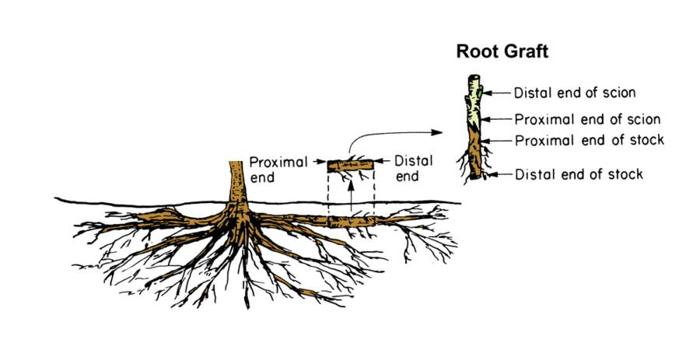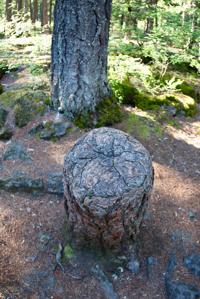Root Grafting

Introduction:
Root grafting is a unique event that can happen both naturally and unnaturally and is when roots of two or more plants fuse together, forming a bond between the two or more roots. This allows for the transfer of water, nutrients, and can even form a signal between the two plants. Root grafting can play an important ecological role in plant species and interactions allowing for stability in an environment both above ground and below.
Mechanism:
Root grafting is a common process that is often found in forested environments within dominant same species trees (with minor exceptions there is the potential for opposite species to allow root grafting) . In order for root grafting to occur there must be a fusion of the vascular systems of two or more roots, once this fusion in completed the trees are able to make a physical connection between each other where they can transfer resources like water, nutrients, and can even create a network between the trees acting like the nervous system in the human body (Quer et al. 2020). For this to occur, trees again must commonly be the same species, be large enough in size to support one another, as well as have big enough roots that they can fuse together and effectively transfer resources from one to another (Lev-Yadun and Sprugel n.d.).
Ecological Significance:

Root grafting is a large sign that competition between different trees has reached an almost stable state in which trees are able to focus all energy on growing instead of competing. Root grafting can occur in a few different ways; one showing the benefits when both trees are alive and one in which one of the trees has died. When both individuals are alive, they hold many benefits between the two like the transfer of nutrients but also many other benefits. These benefits can consist of less chance of disease if the trees are strong and healthy, mating partners and transferring the required gametes from on to another to produce more trees in the area, with the benefit of nutrient transfer there is the positive growth of each tree resulting in a strong canopy and less light being let to the ground (which prohibits small shrubbery from growing and using nutrients in the soils), and can help with chemical defense and resistance to herbivores and/or pathogens (Lev-Yadun and Sprugel n.d.).
Benefits for trees that may have died to some natural cause while grafted with another tree can also lead a fascinating growths. If during a tree’s natural life there is a destructive event that may cause a tree to die or fall over, and that tree’s roots were strongly grafted to a healthy tree there are still positive effects that will occur. One benefits would be that even if a tree dies, its roots remain alive and act as a connector between the trees that are still alive, allowing for the continued transfer of resources between the trees that are still alive. Another benefit that continues on that continued transfer of resource is it allows for more nutrients to be transferred and used by the healthy remaining trees (this follows the simple idea that with one tree dying, there is now less trees alive and using available resources) (Lev-Yadun and Sprugel n.d.). Under the conditions that a tree may have fallen over and the stump still remails intact and the roots stay below ground there is also the event in which living stumps can be formed. This is when the stump of a fallen tree is able to draw enough resources from its grafted roots that will create a scare over then broken wood and instead of growing a new trunk and leaves it simple lives off of the nearby trees and will continue to absorb water and nutrients to stay alive and grow from year to year (Lanner 1961).
Soil Interactions:
None of this transfer of resources would be possible with the hold of mycorrhizal fungi. Mycorrhizal fungi acts as a nervous system for these trees and their grafted roots, enhancing the effectiveness of the roots and increasing the amount of nutrients the roots are able to uptake (“Underground Networking” n.d.). This mutual benefit where the trees retain the necessary nutrients for survival and the fungi receives the necessary carbohydrates to survive (“Mycorrhizae” n.d.). In turn this creates a very diverse soil environment that will then stimulate the growth of many different soil micro and macro invertebrates allowing for a healthy and stable soil environment.
Applications:
Aside from the natural phenomenon of root grafting and its natural benefits, humans have also been able to apply this technique to benefit anthropocentric values as well. Root grafting is a common practice in farming and home planting that allows humans to genetically modify plant gene structure or save dying plants. Root grafting can be used to genetically modify a plant to make it more efficient and useful for human use (“Grafting and Budding Nursery Crop Plants | NC State Extension Publications” n.d.). For example if you have a small but juicy orange and a large but bitter orange tree, if a farmer was to graft the roots of both trees together, the seeds of the conjoined trees can produce a large and juicy orange that is tastier and more ideal to sell in a market. Root grafting can also be used to help heal a dying or injured plant and join its roots with nearby plants or trees to help obtain the necessary nutrients to get healthier.
References:
Grafting and Budding Nursery Crop Plants | NC State Extension Publications. (n.d.). . https://content.ces.ncsu.edu/grafting-and-budding-nursery-crop-plants.
Lanner, R. M. 1961. Living Stumps in the Sierra Nevada. Ecology 42:170–173. https://doi.org/10.2307/1933281
Lev-Yadun, S., and D. Sprugel. (n.d.). Why should trees have natural root grafts? https://doi.org/10.1093/treephys/tpr061
Mycorrhizae. (n.d.). . https://www2.nau.edu/~gaud/bio300/mycorrhizae.htm.
Quer, E., V. Baldy, and A. DesRochers. 2020. Ecological drivers of root grafting in balsam fir natural stands. Forest Ecology and Management 475:118388. https://doi.org/10.1016/j.foreco.2020.118388
Underground Networking: The Amazing Connections Beneath Your Feet. (n.d.). . https://www.nationalforests.org/blog/underground-mycorrhizal-network.